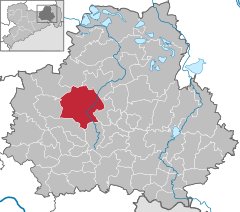Kamenz
Kamenz/Kamjenc | |
|---|---|
 Old town | |
Location of Kamenz/Kamjenc within Bautzen district  | |
| Coordinates: 51°16′N 14°6′E / 51.267°N 14.100°E | |
| Country | Germany |
| State | Saxony |
| District | Bautzen |
| Government | |
| • Mayor (2018–25) | Roland Dantz[1] (Ind.) |
| Area | |
| • Total | 98.30 km2 (37.95 sq mi) |
| Elevation | 173 m (568 ft) |
| Population (2022-12-31)[2] | |
| • Total | 17,015 |
| • Density | 170/km2 (450/sq mi) |
| Time zone | UTC+01:00 (CET) |
| • Summer (DST) | UTC+02:00 (CEST) |
| Postal codes | 01917, 01920 |
| Dialling codes | 03578 |
| Vehicle registration | BZ, BIW, HY, KM |
| Website | www.kamenz.de |
Kamenz (German:
Geography

This small town is located in the west of the
Divisions
The town Kamenz consists of Thale Kamenz and the following Ortschaften or municipal divisions:[3]
- Bernbruch
- Biehla
- Brauna (incl. Liebenau, Petershain, Rohrbach and Schwosdorf)
- Cunnersdorf (incl. Hausdorf and Schönbach)
- Deutschbaselitz/Němske Pazlicy
- Jesau/Jěžow
- Lückersdorf-Gelenau (Lückersdorf, Gelenau and Hennersdorf)
- Thonberg/Hlinowc
- Wiesa/Brěznja
- Zschornau-Schiedel (Zschornau/Čornow and Schiedel)
History
The settlement arose in the late 12th century, when a fortress was erected at the location of today's old town, in order to secure the junction of the medieval Via Regia trade route with the Black Elster river. From here, the Via Regia offered important transport links from the Low Countries up to Silesia.
In 1225, written records first mentioned the town; Kamenz became an independent city in 1319, when Holy Roman Emperor

Kamenz citizens officially turned
With the 1635 Peace of Prague, the Lusatias passed from the Bohemian Crown to the Electorate of Saxony. Several witch-hunts are documented in the 17th century. In 1707 a fire destroyed large parts of the old town. A second major fire on 4 and 5 August 1842 destroyed much of the city.
In 1896, Kamenz became garrison town of the Königlich Sächsisches Reserve-Infanterie-Regiment Nr. 242, part of the German
After the war, the town became part of the
Politics
This section needs to be updated. (July 2021) |

Seats in the city council (Stadtrat) as of 2014 local elections:
- Christian Democratic Union of Germany (CDU): 7
- The Left: 7
- Wählervereinigung Kamenz und Ortsteile (Independent): 3
- Wir für Kamenz (Independent): 2
- National Democratic Party of Germany (NPD): 1
- Free Democratic Party: 1
- Alliance '90/The Greens: 1
Twin towns — sister cities
Kamenz is
Sights

Theatre
- The municipal theatre (Stadttheater) was re-opened in 1999; it is also used for Kabarett and concert performances
- Within the Hutberg landscape park, an open-air stage for up to 10,000 visitors was built in 1934/35 as a Thingplatz; it is today used for music events.
Museums
- Lessing Museum, opened in 1931, memorial site and library
- St Anna abbey church and sacred museum (Klosterkirche und Sakralmuseum St. Annen), part of the former Franciscan convent, exhibits sacred art of the Kamenz churches - a collection of 16th century carved timber painted altarpieces
- Museum of West Lusatia (Museum der Westlausitz): various collections on cultural history, archaeology, geology, zoology, and botany of the region.
Buildings

- Town hall, built in 1848/49, in an Italian Neo-Renaissance style
- Marketplace with Mannerist Andreas Fountain, erected in 1570
- Roter Turm (red tower), Mönchsmauer (monk wall), and Pichschuppen, all remnants of the medieval town fortification
- The Protestant main church of St Mary was built from 1275 to 1479, in a Late Gothic hall church style; it is the only church built from granite rocks north of the Alps
- The nearby Catechism Church at the town wall was first mentioned in 1358; it was later used for religious services held in the Sorbian language
- The St Anne Abbey Church was finished in 1510, now a museum whose collections include five 16th century carved wood altarpieces
- The St Just Church on the historic Via Regia road, first mentioned in 1377, contains several mural paintings from about 1400
- The Lessing memorial marks the place of the poet's birth house.
Events
- Blütenlauf auf dem Hutberg (Run on the Hutberg)
- Lessing Days (every year, January and February)
- Fête de la Musique every year on June 21
- Forstfest (Forest Festival), every year in the week of August 24 on St Bartholomew's Day
- Kamenzer Nasenfest (Nose Festival), Festival with the so-called nose market every year on October 3
- Carnival
- Popular German band Silbermond, originally from the nearby town of Bautzen, have made it a personal tradition to play the final concert of their album tours at Kamenz's Hutbergbühne stadium.
Notable people

- Andreas Dressler (1530-1604), a highly skilled local artist
- Gotthold Ephraim Lessing (1729–1781), philosopher and poet.[6]
- Gottfried von Erdmannsdorff (1893–1946), German Nazi officer executed for war crimes
- Richard Hauptmann (1899–1936), convicted kidnapper of the Lindbergh baby
- Hans Thamm (1921–2007), choral conductor
- Georg Baselitz (born 1938), painter, born in Deutschbaselitz
- Wolfgang Mager (born 1952), rower, two-time Olympic gold medalist
References
- ^ Bürgermeisterwahlen 2018, Freistaat Sachsen, accessed 10 July 2021.
- Statistisches Landesamt des Freistaates Sachsen. 2024.
- ^ Hauptsatzung der Stadt Kamenz, September 2019.
- ^ Słownik geograficzny Królestwa Polskiego i innych krajów słowiańskich, Tom III (in Polish). Warsaw. 1882. p. 798.
{{cite book}}: CS1 maint: location missing publisher (link) - ^ Köhler, Gustav (1846). Der Bund der Sechsstädte in der Ober-Lausitz: Eine Jubelschrift (in German). Görlitz: G. Heinze & Comp. p. 30.
- ^ Sime, James; Robertson, John George (1911). . Encyclopædia Britannica. Vol. 16 (11th ed.). pp. 496–499.
External links
- Municipal site (in German)
- Kamenz at oberlausitz.com
- . Encyclopædia Britannica. Vol. 15 (11th ed.). 1911. p. 646.
- Museum of West Lusatia (in German)
- Lessing Museum (in German)




